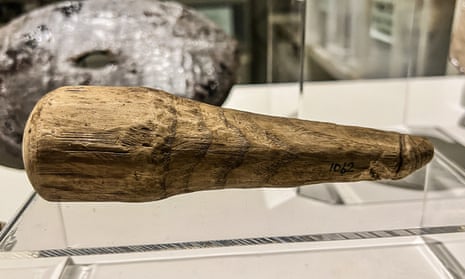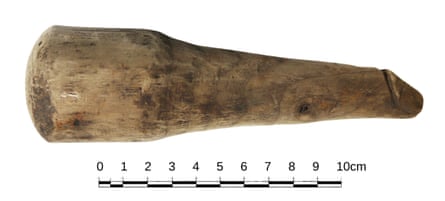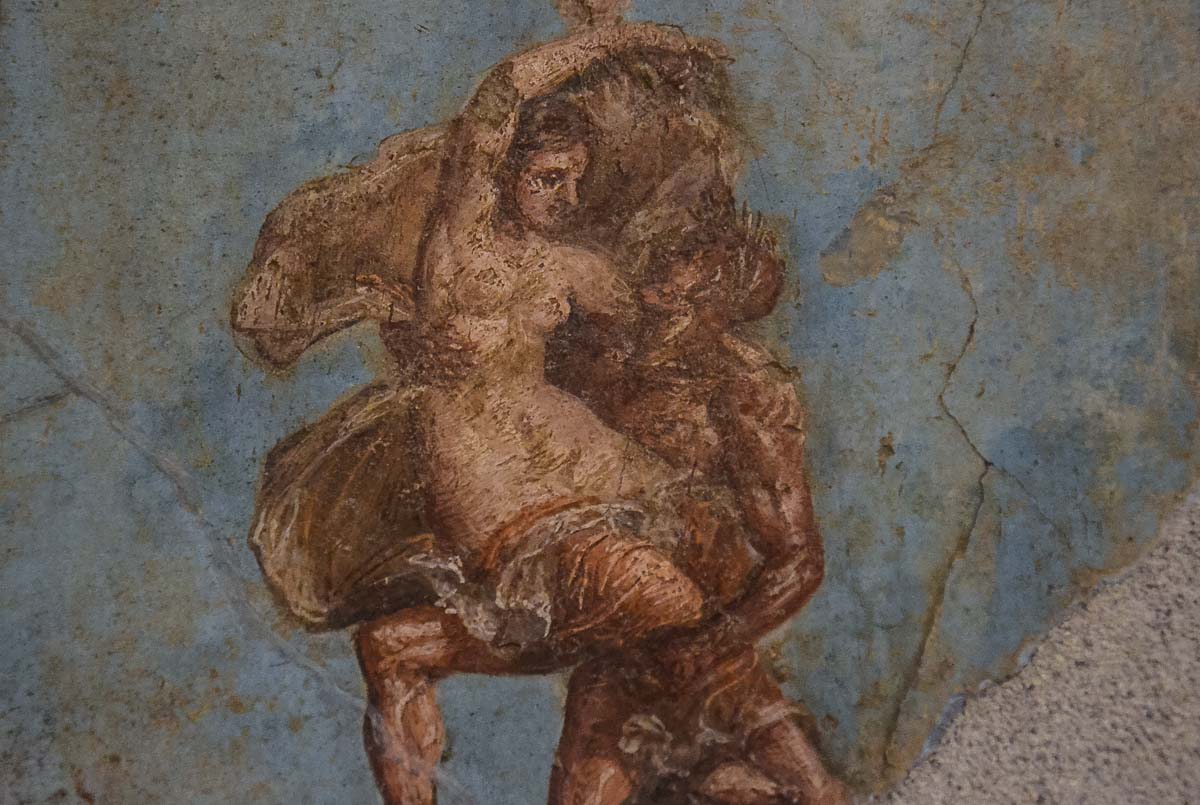Two thousand-year-old object found at Roman fort in Northumberland in 1992 has been reassessed by archaeologists
The Vindolanda wooden phallus. ‘I have to confess,’ said Newcastle university archaeology senior lecturer Rob Collins, ‘part of me thinks it’s kind of self-evident that it is a penis.’ Photograph: Newcastle UniversityArchaeology This article is more than 1 month oldIt’s not a darning tool, it’s a very naughty toy: Roman dildo foundThis article is more than 1 month old

Two thousand-year-old object found at Roman fort in Northumberland in 1992 has been reassessed by archaeologists
Archaeologists believe they may have found the only known lifesize Roman dildo, discovered in a ditch in what were the farthest northern fringes of the empire.
If it was not used as a sexual implement then the 2,000-year-old object may have been an erect penis-shaped pestle, or it could have been a feature from a statue that people touched for good luck.

What it definitely is not is what it was catalogued as after its discovery at the Roman fort of Vindolanda in Northumberland in 1992: a darning tool.
“I have to confess,” said Newcastle University archaeology senior lecturer Rob Collins, “part of me thinks it’s kind of self-evident that it is a penis. I don’t know who entered it into the catalogue. Maybe it was somebody uncomfortable with it or didn’t think the Romans would do such silly things.”
If they did think that, they could not be more wrong given that two- and three-dimensional representations of phalli were ubiquitous in the Roman world, whether in mosaics, frescoes, pot decoration or pendants worn around the neck.
The Vindolanda phallus is 16cm long but, researchers say, was probably larger because archaeological wood is prone to shrinkage and warping.
The phallus is 16cm long but may have shrunk with age. Photograph: Newcastle University
It has been examined by researchers at Newcastle University and University College Dublin. The analysis has revealed it to be, at the very least, the first known example of a disembodied phallus made of wood recovered anywhere in the Roman world.
The phallus was found in a ditch along with dozens of shoes and dress accessories as well as craft waste products such as leather off-cuts and worked antler – perhaps one reason for it being seen as a darning tool.
“What makes this a first is that it is not a small, miniature phallus,” said Collins. “It’s lifesize. It’s also important because wood just doesn’t normally survive … we couldn’t find any parallels.”
The size and uncertainty of function was fascinating, he said. “Often in archaeology when we find an object we can tell what it was used for or deduce what it was used for. That wasn’t the case for this object. We have had to cast our nets wide in thinking what would a six-and-a-half-inch wooden carving of a phallus be used for.

“We had some very interesting discussions.”
Ancient phallic objects were often used for warding off evil. The analysis showed the Vindolanda phallus had notably smoother ends, indicating it was used for something over a period of time.
The team has alighted on three possible theories, all of which are outlined in a detailed discussion paper published in the journal Antiquity.
One theory is that it was used for sexual reasons. That could mean it was a sex toy although some caution is needed, said Collins.
“Sometimes they [dildos] weren’t always used for pleasure … they can be implements of torture so I’m very conscious of using the term sex toy. Hopefully that is what it was used for. That is the most exciting and intriguing possibility.
“If that is the case it would be, to our knowledge, the first Roman dildo that’s been encountered from archaeology. We know from Greek and Roman poetry and Greek and Roman art that they used dildos. But we haven’t had any archaeological examples found which is intriguing in itself.
“If it is that and it is found up here on the northern fringe of the empire and not down in the rich heartland of Roman Italy … it is kind of astounding.”
Theory two is that the object was used as a pestle, either for culinary purposes or to grind cosmetic or medicinal ingredients. Its size would have made it easy to use and the shape would have imbued the food or ingredients with perceived magical properties.
The third option is that it was meant to slot into a statue which passersby would touch for good luck or to absorb or activate protection from misfortune – which was common throughout the Roman empire.
If that was the case, the statue would probably have been located near the entrance to an important building but the evidence indicates that the phallus was either indoors or at least not in an exposed position outside for any length of time.
Researchers hope the Vindolanda phallus will prompt a search for similar objects in other collections. In the meantime it has gone on display at the Vindolanda museum.








